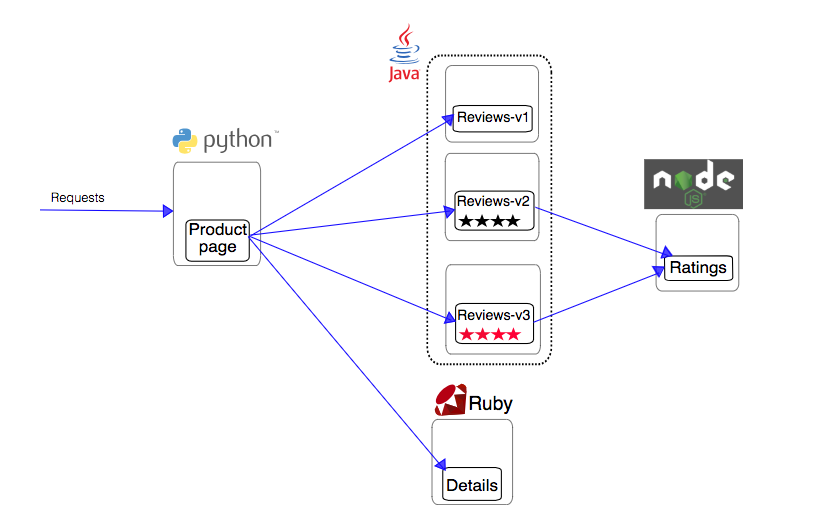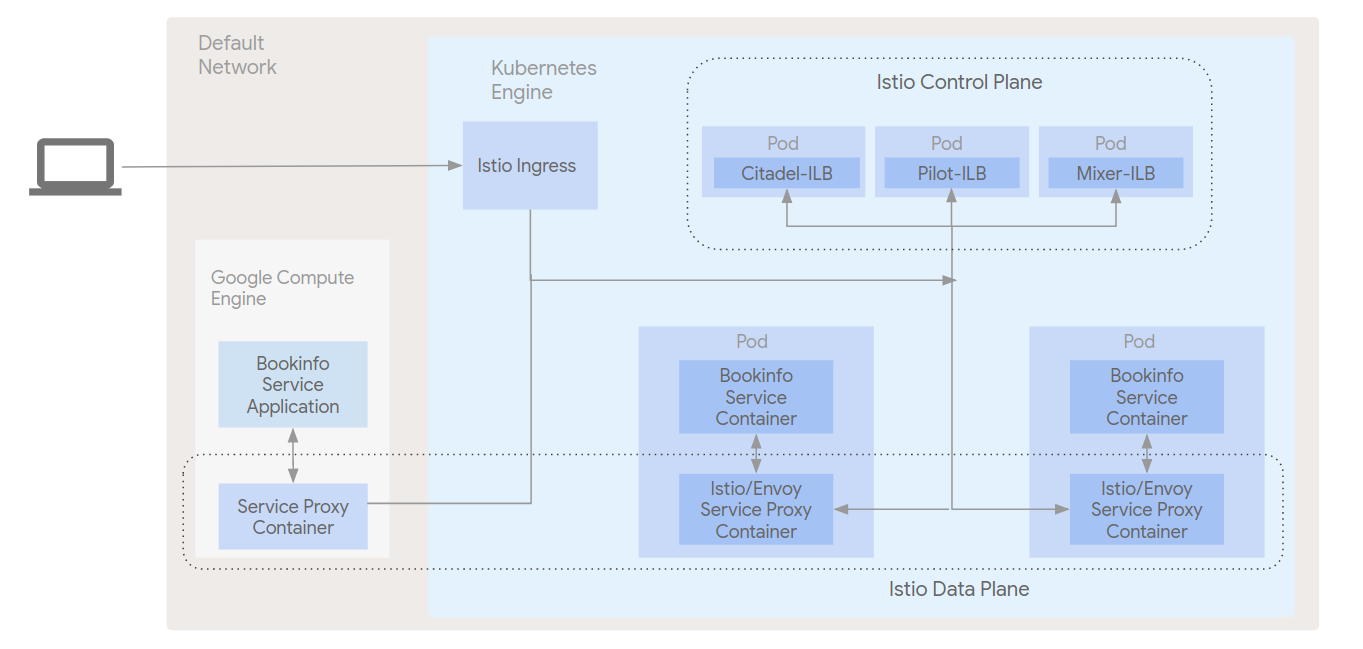In this demo, we leverage Google Kubernetes Engine (Kubernetes Engine) and Google Compute Engine (GCE) to learn more about how Istio can manage services that reside in the network outside of the Kubernetes Engine environment. This demo uses Kubernetes Engine to construct a typical Istio infrastructure and then setup a GCE instance running a MySQL microservice that will be integrated into the Istio infrastructure. We will use the sample BookInfo application and extend it by using the MySQL microservice to house book reviewer ratings. The demo serves as a learning tool and addresses the use case of users who want to leverage Istio to manage other services in their Google Cloud Platform (GCP) environment that may not be ready for migration to Kubernetes Engine just yet.
Istio has two main pieces that create the service mesh: the control plane and the data plane.
The control plane is made up of the following set of components that act together to serve as the hub for the infrastructure's service management.
-
Mixer: a platform-independent component responsible for enforcing access control and usage policies across the service mesh and collecting telemetry data from the Envoy proxy and other services
-
Pilot: provides service discovery for the Envoy sidecars, traffic management capabilities for intelligent routing, (A/B tests, canary deployments, etc.), and resiliency (timeouts, retries, circuit breakers, etc.)
-
Citadel: provides strong service-to-service and end-user authentication using mutual TLS, with built-in identity and credential management.
The data plane is comprised of all the individual service proxies that are distributed throughout the infrastructure. Istio uses Envoy with some Istio-specific extensions as its service proxy. It mediates all inbound and outbound traffic for all services in the service mesh. Istio leverages Envoy’s many built-in features such as dynamic service discovery, load balancing, TLS termination, HTTP/2 & gRPC proxying, circuit breakers, health checks, staged roll-outs with percentage-based traffic splits, fault injection, and rich metrics.
The sample BookInfo application displays information about a book, similar to a single catalog entry of an online book store. Displayed on the page is a description of the book, book details (ISBN, number of pages, and so on), and a few book reviews.
The BookInfo application is broken into four separate microservices and calls on various language environments for its implementation:
- productpage. The productpage microservice calls the details and reviews microservices to populate the page.
- details. The details microservice contains book information.
- reviews. The reviews microservice contains book reviews. It also calls the ratings microservice.
- ratings. The ratings microservice contains book ranking information that accompanies a book review.
There are 3 versions of the reviews microservice:
- Version v1 doesn’t call the ratings service.
- Version v2 calls the ratings service, and displays each rating as 1 to 5 black stars.
- Version v3 calls the ratings service, and displays each rating as 1 to 5 red stars.
To learn more about Istio, please refer to the project's documentation.
The pods and services that make up the Istio control plane is the first part of the architecture that gets installed into Kubernetes Engine, at the time we install the BookInfo application we simultaneously install an istio service proxy alongside each micro service in the application. At this point we have our two tiers that make up the Istio architecture, our Control Plane and our Data Plane, and we have microservices to manage.
In the diagram, note
- all input and output from any BookInfo microservice goes through the service proxy
- each service proxy communicates with each other and the Control plane to implement the features of the service mesh, circuit breaking, discovery, etc.
- the Mixer component of the Control Plane is the conduit for the telemetry add-ons to get metrics from the service mesh
- the Istio ingress component to provide external access to the mesh
- the environment is setup in the Kubernetes Engine default network
In order to use the code in this demo you will need to have have access to a bash shell with the following tools installed:
- A GCP project with billing enabled
- Google Cloud SDK (v204.0.0 or later)\
- kubectl (v1.10.0 or later)
- git
- A bash-compatible shell
To deploy this demo, clone the repository and the shared repository. The shared repository is located here: https://github.com/GoogleCloudPlatform/gke-istio-shared
Once you have both projects cd into this projects directory. Note that this directory is considered the working directory and all of the following commands should be run in it.
- Copy the
propertiesfile toproperties.envand set the following variables in theproperties.envfile: * PROJECT - the name of the project you want to use * REGION - the region in which to locate for all the infrastructure * ZONE - the zone in which to locate all the infrastructure - Run the following command
./setup.shThe script should deploy all of the necessary infrastructure and install Istio.
The script will end with a line like this, though the IP address will be different:
Update istio service proxy environment file
104.196.243.210/productpage
To validate that everything is working correctly, first open your browser to the URL provided at the end of the installation script. Once the ratings service is running correctly, run
./validate.sh <STARS>and substitute for the number of stars to return. The value of must be an integer between 1 and 5.
If you refresh the page in your browser, the first rating should return the number of stars you entered. This shows that the rating has made it to the ratings service. While the database micro service isn't contained in the GKE cluster, it works seemlessly via the Istio data plane.
To tear down the resources created by this demo, run
./teardown.shNOTE - Keep an eye on quotas, the tear down script deletes resources it is aware of but cannot account for all the resources generated during the setup of the infrastructure
This demo was created with help from the following links
- https://cloud.google.com/kubernetes-engine/docs/tutorials/istio-on-gke
- https://cloud.google.com/compute/docs/tutorials/istio-on-compute-engine
- https://istio.io/docs/guides/bookinfo.html
- https://istio.io/docs/setup/kubernetes/mesh-expansion.html
- https://istio.io/docs/guides/integrating-vms.html
This is not an officially supported Google product

